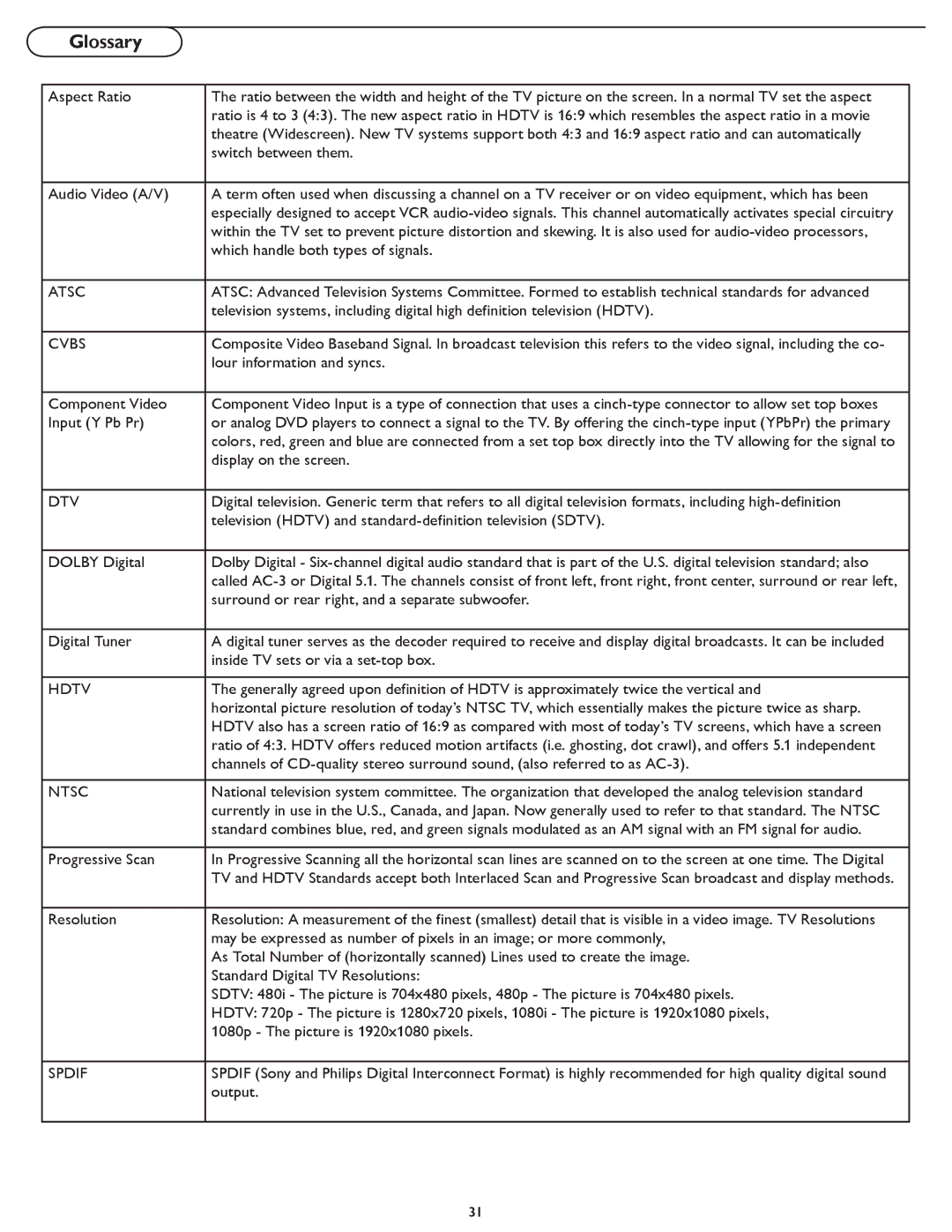Glossary
Aspect Ratio | The ratio between the width and height of the TV picture on the screen. In a normal TV set the aspect |
| ratio is 4 to 3 (4:3). The new aspect ratio in HDTV is 16:9 which resembles the aspect ratio in a movie |
| theatre (Widescreen). New TV systems support both 4:3 and 16:9 aspect ratio and can automatically |
| switch between them. |
|
|
Audio Video (A/V) | A term often used when discussing a channel on a TV receiver or on video equipment, which has been |
| especially designed to accept VCR |
| within the TV set to prevent picture distortion and skewing. It is also used for |
| which handle both types of signals. |
|
|
ATSC | ATSC: Advanced Television Systems Committee. Formed to establish technical standards for advanced |
| television systems, including digital high definition television (HDTV). |
|
|
CVBS | Composite Video Baseband Signal. In broadcast television this refers to the video signal, including the co- |
| lour information and syncs. |
|
|
Component Video | Component Video Input is a type of connection that uses a |
Input (Y Pb Pr) | or analog DVD players to connect a signal to the TV. By offering the |
| colors, red, green and blue are connected from a set top box directly into the TV allowing for the signal to |
| display on the screen. |
|
|
DTV | Digital television. Generic term that refers to all digital television formats, including |
| television (HDTV) and |
|
|
DOLBY Digital | Dolby Digital - |
| called |
| surround or rear right, and a separate subwoofer. |
|
|
Digital Tuner | A digital tuner serves as the decoder required to receive and display digital broadcasts. It can be included |
| inside TV sets or via a |
|
|
HDTV | The generally agreed upon definition of HDTV is approximately twice the vertical and |
| horizontal picture resolution of today’s NTSC TV, which essentially makes the picture twice as sharp. |
| HDTV also has a screen ratio of 16:9 as compared with most of today’s TV screens, which have a screen |
| ratio of 4:3. HDTV offers reduced motion artifacts (i.e. ghosting, dot crawl), and offers 5.1 independent |
| channels of |
|
|
NTSC | National television system committee. The organization that developed the analog television standard |
| currently in use in the U.S., Canada, and Japan. Now generally used to refer to that standard. The NTSC |
| standard combines blue, red, and green signals modulated as an AM signal with an FM signal for audio. |
|
|
Progressive Scan | In Progressive Scanning all the horizontal scan lines are scanned on to the screen at one time. The Digital |
| TV and HDTV Standards accept both Interlaced Scan and Progressive Scan broadcast and display methods. |
|
|
Resolution | Resolution: A measurement of the finest (smallest) detail that is visible in a video image. TV Resolutions |
| may be expressed as number of pixels in an image; or more commonly, |
| As Total Number of (horizontally scanned) Lines used to create the image. |
| Standard Digital TV Resolutions: |
| SDTV: 480i - The picture is 704x480 pixels, 480p - The picture is 704x480 pixels. |
| HDTV: 720p - The picture is 1280x720 pixels, 1080i - The picture is 1920x1080 pixels, |
| 1080p - The picture is 1920x1080 pixels. |
|
|
SPDIF | SPDIF (Sony and Philips Digital Interconnect Format) is highly recommended for high quality digital sound |
| output. |
|
|
31
